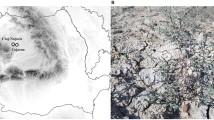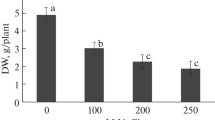Abstract
Growth parameters, the content of proline and flavonoids. Na+ and K+ ion accumulation in the shoots of four species of halophytes from the family Chenopodiaceae inhabiting the territory of the South Urals at different levels of salinity were studied. Within a single taxonomic group, different strategies of salt tolerance related to the level of soil salinity and specific features of salt accumulation in the shoots were revealed. Differences were manifested in the contents of protective compounds (proline and flavonoids) in dependence on the Na+ and K+ ion accumulation in the plant shoots. To characterize the participation of these compounds in plant adaptation to salinity, the ratio proline/flavonoids (Pro/Fl) was introduced. The highest value of Pro/Fl (4.9) was observed in Artiplex tatarica L. growing at weak salinity; in this plant, salt accumulation in the shoots depended on the sodium content in soil. Species Bassia sedoides (Pall.) Aschers., Atriplex verrucifera M. Bieb, and Kochia prostrate (L.) Schrad., with salt accumulation in the shoots independent on the level of soil salinity, inhabited the regions with the higher salinity. In these species the ratio Pro/Fl was 0.2–1.4, i.e., flavonoids, which concentration was positively correlated with the K+ content, played a great and equal to proline role in protective mechanisms. In species B. sedoides and A. verrucifera, the high content of both flavonoids and K+ are indices correlating with high productivity and adaptation to the environment. Proline can be used as a marker of stress only in A. verrucifera, the most salt-tolerant among the studied halophytes. It is concluded that the Pro/Fl ratio in halophytes from the family Chenopodiaceae characterizes the strategies of adaptation depending on salt accumulation in plants.
Similar content being viewed by others
Abbreviations
- Pro/Fl:
-
the ratio of proline to flavonoid content
References
Zhu, J.K., Plant salt tolerance, Trends Plant Sci., 2001, vol. 6, pp. 66–71.
Flowers, T. and Colmer, T., Salinity tolerance in halophytes, New Phytol., 2008, vol. 179, pp. 945–963.
Roohi, A., Nazish, B., Nabgha-e-Amen, Maleeha, M., and Waseem, S., A critical review on halophytes: salt tolerant plants, J. Medic. Plant Res., 2011, vol. 5, pp. 7108–7118.
Szabados, L. and Savouré, A., Proline: a multifunctional amino acid, Trends Plant Sci., 2010, vol. 15, pp. 89–97.
Matysik, J., Alia, A., Bhalu, B., and Mohanty, P., Molecular mechanisms of quenching of reactive oxygen species by proline under stress in plants, Curr. Sci., 2002, vol. 82, pp. 525–532.
Alia, P.S. and Mohanty, P., Involvement of proline in protecting thylakoid membranes against free radicalinduced photodamage, J. Photochem. Photobiol., 1997, vol. 38, pp. 253–257.
Okuma, E., Soeda, K., Fukuda, M., Tado, M., and Murata, Y., Negative correlation between the ratio of K+ to Na+ and proline accumulation in tobacco suspension cells, Soil Sci. Plant Nutr., 2002, vol. 48, pp. 753–757.
Bano, S. and Bano, A., Physiological and biochemical analysis of the selected halophytes of district Mardan, Pakistan, Int. J. BioSci. Biochem. Bioinf., 2011, vol. 1, pp. 239–243.
Aziz, I., Gul, B., Gulzar, S., and Khan, M.A., Seasonal variations in plant water status of four desert halophytes from semi-arid region of Karachi, Pak. J. Bot., 2011, vol. 43, pp. 587–594.
Falcone Ferreyra, M.L., Rius, S.P., and Casati, P., Flavonoids: biosynthesis, biological functions, and biotechnological applications, Front Plant Sci., 2012, vol. 3, p. 222.
Kutchan, T.M., Ecological arsenal and developmental dispatcher. The paradigm of secondary metabolism, Plant Physiol., 2001, vol. 125, pp. 58–60.
Nosov, A.M., Function of secondary plant metabolites in vivo and in vitro, Sov. Plant Physiol., 1994, vol. 41, pp. 873–878.
Winkel-Shirley, B., Biosynthesis of flavonoids and effects of stress, Curr. Opin. Plant Biol., 2002, vol. 5, pp. 218–223.
Bradshaw, H.D. and Schemske, D.W., Allele substitution at a flower colour locus produces a pollinator shift in monkey flowers, Nature, 2003, vol. 426, pp. 176–178.
Rakhmankulova, Z.F., Fedyaev, V.V., Podashevka, A.A., and Usmanov, I.Yu., Alternative respiration pathways and secondary metabolism in plants with different adaptive strategies under mineral deficiency, Russ. J. Plant Physiol., 2003, vol. 50, pp. 206–212.
Ibrahim, M.H., Jaafar, H.Z., Rahmat, A., and Rahman, Z.A., The relationship between phenolic and flavonoids production with total nonstructural carbohydrate and photosynthetic rate in Labisia pumila Benth. under high CO2 and nitrogen fertilization, Molecules, 2011, vol. 16, pp. 162–174.
Metlen, K.L., Aschehoug, E.T., and Callaway, R.M., Plant behavioural ecology: dynamic plasticity in secondary metabolites, Plant Cell Environ., 2009, vol. 32, pp. 641–653.
Brunetti, C., di Ferdinando, M., Fini, A., Pollastri, S., and Tattini, M., Flavonoids as antioxidants and developmental regulators: relative significance in plants and humans, Int. J. Mol. Sci., 2013, vol. 14, pp. 3540–3555.
Michalak, A., Phenolic compounds and their antioxidant activity in plants growing under heavy metal stress review, Pol. J. Environ. Stud., 2006, vol. 15, pp. 523–530.
Edreva, A., Velikova, V., Tsonev, T., Dagnon, S., Gürel, A., Aktaş, L., and Gesheva, E., Stress-protective role of secondary metabolites: diversity of functions and mechanisms, Gen. Appl. Plant Physiol., 2008, vol. 34, pp. 67–78.
Buhmann, A. and Papenbrock, J., An economic point of view of secondary compounds in halophytes, Funct. Plant Biol., 2013, vol. 40, pp. 952–967.
Radyukina, N.L., Ivanov, Yu.V., and Shevyakova, N.I., Methods for assessing the content of reactive oxygen species, low-molecular antioxidants, and activities of main antioxidant enzymes, Molekulyarno-geneticheskie i biokhimicheskie metody v sovremennoi biologii rastenii (Molecular, Genetic, and Biochemical Methods in Current Plant Biology), Kuznetsov, Vl.V., Kusnetsov, V.V., and Romanov, G.A., Eds., Moscow: Binom, 2011, pp. 347–365.
Balnokin, Yu.V., Ionnyi gomeostaz i soleustoichivost’ rastenii. 70-e Timiryazevskoe chtenie (Ion Homeostasis and Salt Tolerance of Plants, the 70th Timiryazev Lecture), Moscow: Nauka, 2012.
Balnokin, Yu.V., Kurkova, E.B., Myasoedov, N.A., Lun’kov, R.V., Shamsutdinov, N.Z., Egorova, E.A., and Bukhov, N.G., Structural and functional state of thylakoids in a halophyte Suaeda altissima before and after disturbance of salt-water balance by extremely high concentrations of NaCl, Russ. J. Plant Physiol., 2004, vol. 51, pp. 815–821.
Balnokin, Yu.V., Myasoedov, N.A., Shamsutdinov, Z.Sh., and Shamsutdinov, N.Z., Significance of Na+ and K+ for sustained hydration of organ tissues in ecologically distinct halophytes of the family Chenopodiaceae, Russ. J. Plant Physiol., 2005, vol. 52, pp. 779–787.
Orlova, Yu.V., Myasoedov, N.A., Kirichenko, E.B., and Balnokin, Yu.V., Contributions of inorganic ions, soluble carbohydrates, and multiatomic alcohols to water homeostasis in Artemisia lerchiana and A. pauciflora, Russ. J. Plant Physiol., 2009, vol. 56, pp. 200–210.
Wyn Jones, G. and Gorham, J., Intra- and inter-cellular compartments of ions, Salinity: Environment-Plant-Molecules, Läuchli, A. and Lüttge, U., Eds., Dordrecht: Kluwer, 2002, pp. 159–180.
Storey, R. and Wyn Jones, G., Betaine and choline levels in plants and their relationship to NaCl, Stress. Pl. Sci. Lett., 1975, vol. 4, pp. 161–168.
Shabala, S. and Shabala, L., Ion transport and osmotic adjustment in plants and bacteria, Biol. Mol. Concepts, 2011, vol. 2, pp. 407–419.
Ksouri, R., Smaoui, A., Isoda, H., and Abdelly, C., Utilization of halophyte species as new sources of bioactive substances, J. Arid Land Stud., 2012, vol. 22, pp. 41–44.
Author information
Authors and Affiliations
Corresponding author
Additional information
Original Russian Text © Z.F. Rakhmankulova, E.V. Shuyskaya, A.V. Shcherbakov, V.V. Fedyaev, G.Ya. Biktimerova, R.R. Khafisova, I.Yu. Usmanov, 2015, published in Fiziologiya Rastenii, 2015, Vol. 62, No. 1, pp. 79–88.
Rights and permissions
About this article
Cite this article
Rakhmankulova, Z.F., Shuyskaya, E.V., Shcherbakov, A.V. et al. Content of proline and flavonoids in the shoots of halophytes inhabiting the South Urals. Russ J Plant Physiol 62, 71–79 (2015). https://doi.org/10.1134/S1021443715010112
Received:
Published:
Issue Date:
DOI: https://doi.org/10.1134/S1021443715010112




